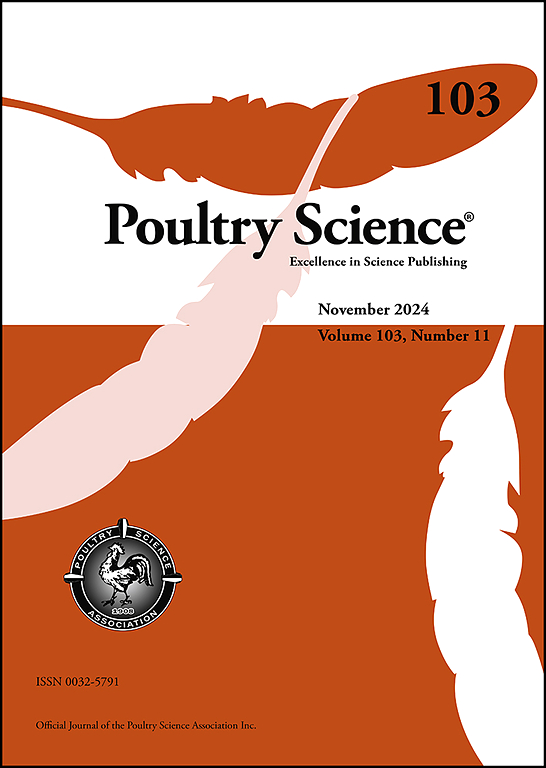Top-view characterization of broiler walking ability and leg health using computer vision
IF 3.8
1区 农林科学
Q1 AGRICULTURE, DAIRY & ANIMAL SCIENCE
引用次数: 0
Abstract
Impaired walking ability and leg health are commonly seen in broilers and can negatively impact their welfare. Commonly, walking ability and leg health are assessed manually, but this is time consuming and can be subjective. Automated approaches for scoring walking ability and leg health at the individual level could therefore have great added value. Here, we studied whether automatically extracted top-view walking features of broilers can be used as a proxy for walking ability and leg health. Top-view videos were collected of unmarked broilers walking through a corridor that was placed inside the home pen. From these videos, four top-view features were derived: 1) lateral body oscillation, calculated as deviations from the movement trajectory of the bird, 2) step count, 3) completion time, and 4) length-width ratio of the virtual bounding box encapsulating the bird while walking as an indicator of wing support. We assessed the relationship of these computer vision-based features with manual gait and leg health scores, including hock burn (HB) and footpad dermatitis (FPD). We observed that birds with worse gait scores (GS) had longer completion times, higher step counts and a trend for higher lateral body oscillation levels in the walkway setup. Unsupervised clustering using the K-means algorithm with these walking features showed potential to distinguish birds with GS3+, although differentiating between GS1 and GS2 proved more challenging. We concluded that the length-width ratio of the bounding box during walking was not a suitable proxy for poor gait. We found no relationship between top-view walking features and mild cases of HB and FPD in broilers. Overall, the results of this study indicate that top-view video recordings can provide insight into birds’ walking ability, using features related to movement speed, step count and lateral body oscillation, making automated scoring more feasible on a larger scale in practice. However, these top view features provide little information about mild HB and FPD.
利用计算机视觉对肉鸡行走能力和腿部健康进行俯视图表征。
行走能力和腿部健康受损在肉鸡中很常见,并可能对它们的福利产生负面影响。通常,步行能力和腿部健康是手动评估的,但这既耗时又主观。因此,在个人水平上对行走能力和腿部健康进行评分的自动化方法可能具有很大的附加价值。在此,我们研究了自动提取的肉鸡俯视图行走特征是否可以作为行走能力和腿部健康的代表。俯视图视频收集了没有标记的肉鸡走过放置在家庭围栏内的走廊的视频。从这些视频中,我们得到了四个俯视图特征:1)侧向身体振荡,计算出与鸟的运动轨迹的偏差,2)步数,3)完成时间,以及4)行走时封装鸟的虚拟边界盒的长宽比,作为翅膀支撑的指标。我们评估了这些基于计算机视觉的特征与手动步态和腿部健康评分的关系,包括跗关节烧伤(HB)和足垫皮炎(FPD)。我们观察到,步态评分(GS)较差的鸟类完成时间更长,步数更高,并且在走道设置中有更高的侧体振荡水平的趋势。使用具有这些行走特征的K-means算法的无监督聚类显示出区分GS3+鸟类的潜力,尽管区分GS1和GS2被证明更具挑战性。我们得出的结论是,行走时边界框的长宽比不是步态不良的合适代表。我们发现肉鸡俯视图行走特征与轻度HB和FPD病例之间没有关系。总体而言,本研究的结果表明,俯视图视频记录可以利用与移动速度、步数和侧体振荡相关的特征,深入了解鸟类的行走能力,使自动化评分在实践中更大规模地可行。然而,这些俯视图特征提供的关于轻度HB和FPD的信息很少。
本文章由计算机程序翻译,如有差异,请以英文原文为准。
求助全文
约1分钟内获得全文
求助全文
来源期刊

Poultry Science
农林科学-奶制品与动物科学
CiteScore
7.60
自引率
15.90%
发文量
0
审稿时长
94 days
期刊介绍:
First self-published in 1921, Poultry Science is an internationally renowned monthly journal, known as the authoritative source for a broad range of poultry information and high-caliber research. The journal plays a pivotal role in the dissemination of preeminent poultry-related knowledge across all disciplines. As of January 2020, Poultry Science will become an Open Access journal with no subscription charges, meaning authors who publish here can make their research immediately, permanently, and freely accessible worldwide while retaining copyright to their work. Papers submitted for publication after October 1, 2019 will be published as Open Access papers.
An international journal, Poultry Science publishes original papers, research notes, symposium papers, and reviews of basic science as applied to poultry. This authoritative source of poultry information is consistently ranked by ISI Impact Factor as one of the top 10 agriculture, dairy and animal science journals to deliver high-caliber research. Currently it is the highest-ranked (by Impact Factor and Eigenfactor) journal dedicated to publishing poultry research. Subject areas include breeding, genetics, education, production, management, environment, health, behavior, welfare, immunology, molecular biology, metabolism, nutrition, physiology, reproduction, processing, and products.
 求助内容:
求助内容: 应助结果提醒方式:
应助结果提醒方式:


